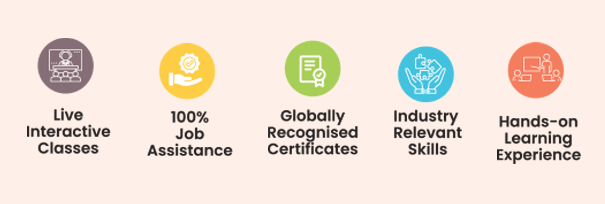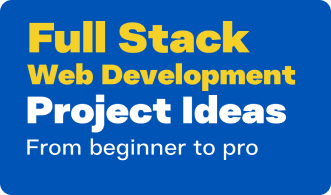From working on the front-end presentation layer to managing the back-end server side, a database layer, and everything in between, full-stack development is all about designing the overall look and feel of a website or an application while assessing the technical and functional capabilities.
‘Front-end is the visible part of the web application or website, responsible for user experience, and involves working on JavaScript, CSS, HTML, etc. Back-end refers to the server-side development of a website or web application focusing on the website’s working. It is built using frameworks, libraries and languages like PHP, C++, Java, and Python.
To make the working of full-stack developers easier, tons of full-stack developer tools, from IDEs to project management apps, are introduced. However, with many options, selecting the best tools for a developer is quite confusing.
Suppose you’re an aspiring full-stack developer looking for the details of the best full-stack development tools kit 2023. In that case, we have covered all details for essential tools, technologies and frameworks for you in the sections below.
Scroll down for an effective learning session!
Front-End Technologies and Frameworks
Front-end of a web application or a website is built using some languages, which include –
HTML –
HTML (Hyper Text Markup Language) defines the link between the web and pages. This combination of hypertext and markup language consists of a series of elements that defines the text documentation within a tag, describing the structure of the web pages.
CSS –
CSS (Cascading Style Sheets) makes webpages presentable by applying styles describing the display of HTML elements on paper, screen and other media platforms. It saves a lot of work, allowing developers to control multiple web page layouts simultaneously.
JavaScript –
JavaScript is a scripting language that enables developers to create dynamically updated content, animate images, and control multimedia, improving the user experience of a website by adding interactive elements and features.
Angular.JS –
Providing enhanced value to normal HTML operations, the Angular.JS framework uses HTML as its base and is used to handle or create a dynamic view.
Python –
Python, a general-purpose programming language, focuses on the code readability factor and supports various paradigms like procedural, functional or object-oriented programming.
SQL –
SQL (Structured Query Language) is significantly used in database management. This domain-specific language is built to serve two primary purposes-
- To handle and manipulate stored data in RDBMS (Rational Database Management System).
- Used to stream processing in RDBMS.
Bootstrap –
Bootstrap is a popular open-source and free CSS, HTML and JavaScript library which consists of forms, navigation, typography, buttons and other interface components based on JavaScript and CSS design templates.
React.js –
Maintained by Facebook, React.js is a flexible, declarative and efficient JavaScript library for developing user interfaces and is responsible only for the website’s view layer (front-end).
Back-End Technologies and Frameworks
Full-stack developers’ job does not end at front-end development. They are also responsible for functionality required behind the scenes, and we have summed up the list of most valuable tools that will efficiently help get the job done-
C++
C++ is an object-oriented and general-purpose programming language widely used for competitive programming and to create high-performance applications.
PHP –
PHP, an acronym for Hypertext Preprocessor, is a widely used, open-source scripting language specifically designed for web development. And since PHP codes are executed on the back-end (server-side), it is also known as a server-side scripting language.
Java –
Java is a profoundly used programming language for coding web applications, games, desktop and mobile applications, database connections, web and application servers, and more.
Python –
Python is also used for back-end functioning, allowing developers to work quickly and integrate systems efficiently.
Ruby on Rails –
It is an open-source server used for server-side development and works on Ruby. It includes all the default options required to develop database-based web applications and has an MVC (Model-View-Controller) framework.
NodeJS –
Built on Chrome’s V8 Javascript engine, this is a run-time JavaScript environment with an event-driven architecture. NodeJS can be used to create dynamic webpage along with server-side operations and helps reduce the number of codes required to be written for operation.
EmberJS –
EmberJS is another open-source JavaScript framework that helios create scalable single-page applications.
ASP.net –
This open-source and free framework creates web applications and services, uses C# and .NET, and supports various platforms.
MySQL –
MySQL is an open-source, one of the sots widely used databases available on leading operating systems like Solaris, Windows and Linux. It stores data in rows, columns and tables.
Django –
This open-source web framework is written using Python and follows the model-tempelate-view-architectural pattern. Django can facilitate quick code development that is clear and effective for server scripting.
MongoDB –
Modern developers who don’t require SQL and circumvent it as document-based can use MongoDB. It is known to maintain high-security levels of data and comes in a cloud version.
Other Important Full-Stack Developer Tools
CodePen –
It is a front-end developer-specific and web designer development environment that facilitates deployment and building of websites, efficient and rapid change of website’s appearance.
GitHub –
Used by over 2 million companies, GitHub facilitates team collaboration in real-time for projects, makes the code-writing process easier by mitigating errors, and can be used to host code as well.
.npm –
NodeJS is a JavaScript eun-the environment, and .npm is a default package manager for it. It facilitates installing, publishing and developing node-based programs.
TypeScript –
TypeScript is a typed JavaScript superset that compiles and cleans JavaScript codes for better application. Some of its significant features also allow static code verification, support multiple JS libraries and run on various platforms.
Slack –
Slack is a cloud-based software that facilitates team collaboration and is essential for full-stack developers. It allows the creation of an online workspace where all the developers and other team members can connect and chat regarding project workings.
BackBone –
Backbone is used to add structure to codes written in JavaScript using Backbone.js and is an excellent source for one-page applications.
Are These Tools Enough to Become a Full-Stack Developer?
After reading all the details for front-end and back-end technologies and frameworks, full-stack developers might wonder whether these tools’ knowledge, use and application are enough to become a successful full-stack developer!
Our team of well-trained, certified and experienced IT experts trainers at Grras Solutions believe that an advanced level of understanding of complete stack development tools, along with other soft skills including problem-solving, quick learning, timeliness, ability to work under pressure, patience, creativity and attention to details are also required to become a successful full-stack developer in 2023.
For all those planning to be successful full-stack developers, Grras Solution offers an exceptional full-stack training program to achieve success in this rising, competitive technical field.






